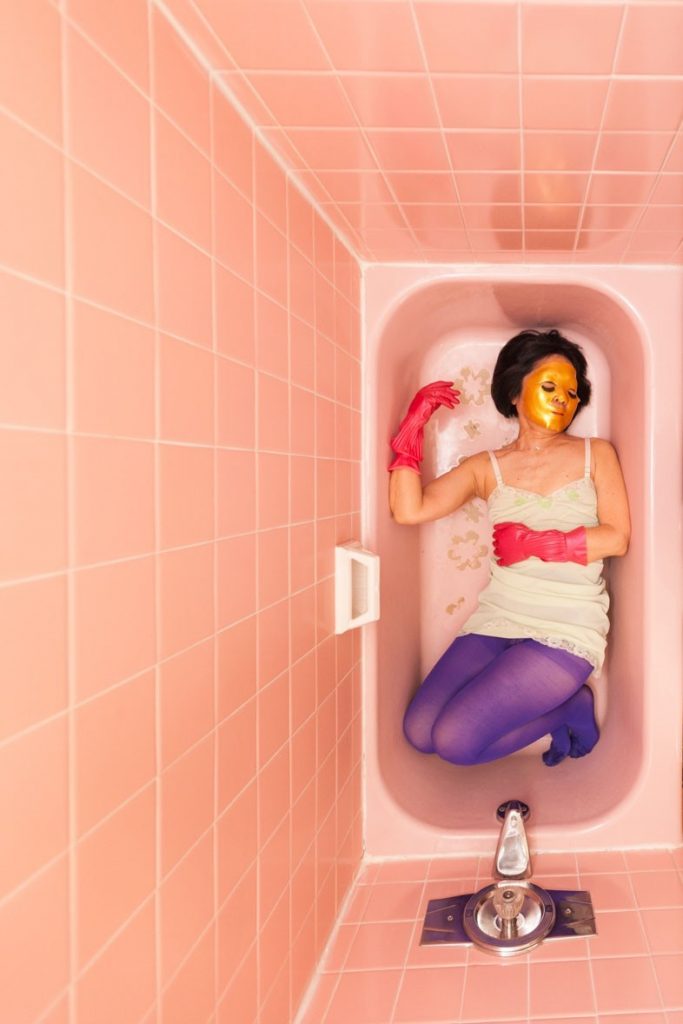Two photography exhibitions currently on view, Tableau and Transformation, and Contemporary Performance, at the Tampa Museum of Art and the Florida Museum of Photographic Arts respectively, explore themes of artifice and theatricality in photography since the mid-20th century. Viewed together they harmonize visual trends that came after modernism and that have persisted through the first decades of the 21st century.
Both exhibitions feature photographs that explicitly or implicitly reference cinema, a perfect art-world counterpoint to summer blockbuster movie season. The term “directorial mode,” coined by photo critic A. D. Coleman in 1977, is the relevant visual framework for many of the works in both exhibitions. Photographs in the directorial mode disrupt the tendency to read a photo as an unmediated truth or a slice of life, injecting instead theatricality and obvious created-ness.
Photos in the directorial mode are, quite simply, staged (though I cringe at that term because in photography it seems to carry a pejorative note–again because the expectation is that photographs are supposed to be “natural”). In Coleman’s words, “[Photographers] have simply substituted the credence with which photographs are normally approached for the suspension of disbelief which effective theater wins from its audience.”
Tableau and Transformation is a selection of photographs in the Museum’s permanent collection, with several loans from the collection of Tampa’s Trenam Law throughout. The corporate photography collection of Trenam Law is a sister collection of sorts to the TMA thanks to the cross-institutional efforts of William K. Zewadski at Trenam and Julie Saul of the Julie Saul Gallery in New York throughout the 1980s. It reads like a who’s who of photographic and conceptual artists from the 1960s forward, including important artists like Andres Serrano, William Wegman, John Baldessari, and Sandy Skoglund.

A staged photograph can take many varied forms, which accounts for the visual diversity in Tableau and Transformation. It may literally reference the proscenium stage as Eileen Cowin’s Untitled (The Bathers) (1987) does, with its freeze-frame dramatically posed figures and deep green velvet curtains at stage right and left. Still lives, composites, and portraits can all be staged. There are narratives and nudes, altered polaroids (Lucas Samaras), and straightforward photos of Weimaraners (William Wegman). Even landscapes that are simply reporting on the scene before the camera, such as the trio of photos by Joel Sternfeld, feel staged, like scouted locations, sets that are awaiting their actors. The sheer diversity of possibility of staged photos, or unstaged photos that feel constructed, leads to an almost infinitely open theme. The TMA has strong holdings in 20th century photography and this is an opportunity to see some of its most important objects in that part of the collection.
Contemporary Performance at FMoPA features works from world-renowned photographers like Cindy Sherman (also represented in Tableau and Transformation) and Deborah Willis as well as emerging artists who matriculated locally, Becky Flanders and Selina Romàn among them. It is a tactile, sensory exhibition. The photographs within share vibrant color palettes and an insistent focus on the human figure. It, too, is comprised of photographs that are created in the directorial mode, though unlike Tableau and Transformation, it is more narrowly focused on narrative suggested by the actions of the people in the frame.
The title, Contemporary Performance, will clue some viewers in to what they may expect in the exhibition, though it is a reference that may resonate only with art-world insiders. Guest curator Kalup Linzy is himself an internationally significant multidisciplinary artist (most notably performance, music, and video) who took his MFA at USF in 2003.
Performance in art is different than performance of a play or of a role in a film. In art, the term is laden with decades of layered, often self-referential context and criticism. “Performance” can mean any and all of: a scripted video work; an ephemeral action designed to be experienced once with no connection to the art market (i.e., without an artifact to be later sold); or the photographic or video documentation of an ephemeral action that is intended to be sold. One-time performances from the 1960s and 70s are now commonly being reenacted by a new generation of artists, adding more layers of signification to the work in a new context. It is not uncommon to hear the term used in the context of performing gender, or to perform other aspects of one’s identity, often to open a space for critique of established social norms. In other words, it is a big term with many potential (and potentially conflicting) interpretations.
The type of performance that the work in the exhibition seems to relate to is the materiality of the human body as a mode of expression or recognizable structure for other variables. Based on the images alone, it seems that the presence of the figure is the connective thread. Locating the site of performance in each image, however, is challenging.
The exhibition provides no contextualization or didactic text beyond the very broad subtitle or description “explores gender, sexuality, class, race, and social identities, and will feature lens based works that convey, elude [sic] to, or concern itself with ideas encompassing performance and role playing.” This has the potential to leave viewers grasping for interpretive threads and possibly not finding them.
Questions I had as an informed art viewer were: How does each photo relate to the theme? What is the contribution of each artist to the curator’s vision? Maybe most importantly, which images show the artist participating in role play? It is not always obvious, especially if one doesn’t know what the artists look like. The professor in me wanted these terms to be defined as they relate to individual photographs within. Which images were dealing with role-playing and which were dealing with social identities? Or more broadly, which, if any, are tongue-in-cheek and which are meant to provoke serious discussion? It is not always easy to locate these important differences with visual information only. This exhibition, including most of the works at an individual level, would benefit from more contextualization for the viewer.
The most striking example of the need for context is in relation to the photograph CREMASTER 3: I Die Daily (2002) by Bjork’s ex-husband, Matthew Barney. When a viewer is confronted with the challenging image, they should have some guidance to help them through the ordeal of looking. Barney is a notorious artist who punishes his body in his performances. He is best known for The Cremaster Cycle, a suite of five big-budget feature-length films (a highly unusual format for video/performance art) in which he performs any number of athletic stunts as metaphors for initiation rites. All students of contemporary art know his name and may recognize some of his iconic imagery, such as the red mouthed Apprentice in his pink kilt and headdress, yet far fewer have ever viewed the Cremaster films because they sell for $100,000 per set, are unreleased individually, and are screened rarely, all by the artist’s decree.
The photograph is disturbing: Barney is in a surgical suite, surrounded by a group of authoritative men wearing aprons that reference those of Freemasons–they all look directly out of the frame at the viewer. His body is partially wrapped in white sheets, his head is covered by a hood with runnels of red coming from the hole cut into the hood, filled by what appears to be a metallic object that must be in his mouth. Barney’s testicles are fitted with an inscrutable white plastic device–is it a surgical tool? The artist’s perineum is at the viewer’s eye-level (possibly referencing the cremaster muscle for which his work is named), and something soft and pink seems to be slithering off the gynecological exam chair and toward the viewer (is it meant to evoke a severed penis, or prolapsed intestines?). I think there are also teeth.
This image is presented without any didactic text to help situate the viewer in relation to what they are seeing. The decision to forego interpretive didactic text is common in commercial art galleries, where viewers are invited to experience the work and bring their own interpretation. Possibly this was a deliberate choice by Linzy to emulate that experience–it is, however, highly unorthodox in museum practice.
Those of us versed in contemporary art are hard to shock, but we would all do well to remember that our familiarity with images like this is rarified and reified, as access to Barney’s videos make clear. To introduce an image like this to an unsuspecting public without any interpretive guidance, in my opinion, has the potential to further alienate viewers who already find contemporary art inscrutable.

Barney’s work in the exhibition is exceptional both in its difficulty and its obscurity. The majority of the images, even if the relationship to an aspect of performance is not clearly defined, are engrossing in the narratives they suggest. Selina Romàn’s Drowning in a Desert (2016) feels like a still from a much larger story that leaves the viewer wanting to know more.

Salty and Fresh (2014) by Paula Wilson is a delightful video that makes the role of artist as performer for her public very clear. In the video Wilson is in a structural dress that elevates her about 10 feet above the sea that she’s standing in. She holds a giant palette and is painting her models’ bodies with a paintbrush several yards long while onlookers picnic on the shore and document the spectacle with their phones. The dress structure renders her unable to move and must continually face the audience and paint her models. If Barney’s Cremaster references the endurance model of being an artist in the public eye, this is a more lighthearted and accessible way to communicate the public persona that artists must perform, tolerate, and embrace.
Bay Art Files contributor Sabrina Hughes holds an M.A. in Art History from the University of South Florida, with a focus on the History of Photography. Hughes has worked at the National Gallery of Art and the Museum of Fine Arts, St. Petersburg and is an adjunct instructor at USF and is the founder and principal of photoxo, a personal archiving service specializing in helping people preserve their family photos. She also has an ongoing curatorial project, Picurious, which invests abandoned slides with new life. Follow her on Instagram @sabrinahughes for selfies, hiking, and dogs, and @thepicurious for vintage photos.
Tableau and Transformation: Photography from the Permanent Collection is on view at the Tampa Museum of Art through Sunday, October 20, 2019. Julie Saul, of the Julie Saul Gallery in New York, was instrumental in developing the Museum’s interest in collecting contemporary photography and will be speaking at a Tampa Collects evening event at the Museum on Tuesday, October 1st. For information about attending and joining Tampa Collects, please contact Kate Douglass at the Tampa Museum of Art.
Contemporary Performance remains on view at the Florida Museum of Photographic Arts through Saturday, August 31, 2019. There will be a special closing reception on Friday, August 23, 2019 starting at 5:00 pm, with a lecture featuring the exhibition’s curator Kalup Linzy following at 6:00 pm. For additional information about attending the public event, please contact the Museum.
